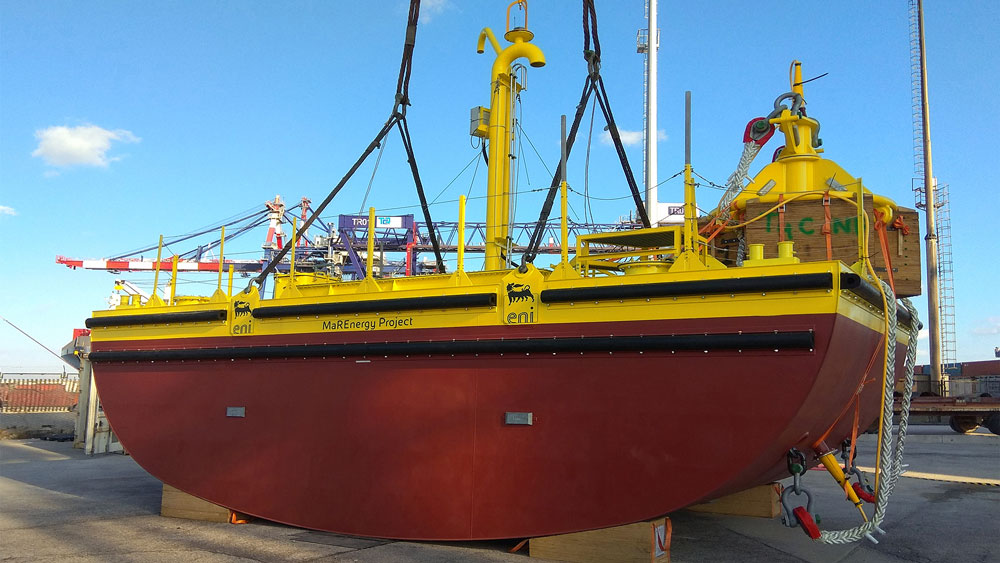Business-Academia Collaboration on Marine Energy Resources Project
Eni and Politecnico di Torino Signed MoU
The Rector of the Politecnico di Torino, Professor Guido Saracco, and Eni’s CEO, Claudio Descalzi, have signed a Memorandum of Understanding to further strengthen scientific collaboration and undertake a joint academic initiative to study marine energy resources.
This agreement will involve the launch of the ‘MarEnergy Lab’ research laboratory, which will investigate specific issues, enhance related understanding, and also contribute to the rapid deployment of industrial technologies that use marine energy resources. Furthermore, a teaching position on ‘Energy from the Sea’ will be created to train engineers who will specialise in the use of the new technologies developed in the laboratory itself.
The Politecnico di Torino is a leading global player in the study and development of technologies for the use of marine renewable sources, particularly wave motion.
Drawing on company experience in the field of offshore activities and marine installations, Eni has developed the first integrated power generation plant in the world using wave and photovoltaic energy: the Intertial Sea Wave Energy Converter (ISWEC). This project has been undertaken in collaboration with The Politecnico di Torino and Wave for Energy, a subsidiary of the Politecnico. The ISWEC has been operating since March 2019 in the Ravenna offshore and has proven highly reliable and able to adapt to different sea conditions, thanks to its active control and regulation system. During the operating period, the maximum nominal power value of 50 kW was exceeded.
This Agreement will ensure that the collaboration between both parties further widens to include joint activities in the study of marine energy sources, and extending to wave motion as well as offshore wind power, ocean currents and tides, and saline gradients.
“Thanks to this strengthened collaboration with the Politecnico di Torino, Eni reaffirms its commitment to the development and implementation of new technologies which will play a key role in decarbonisation, looking forward to new energy frontiers with a focus on the largest unused renewable energy source in the world: waves,” CEO Eni Claudio Descalzi said.
“Collaborating with Eni in a sector of strategic importance for the planet as is energy production from renewable sources, exemplifies open innovation at our University’s research laboratories. Our laboratories have completed all the necessary preparatory stages, from creating the Wave for Energy subsidiary, to its adoption by a large industrial group. This agreement further enhances our collaboration with Eni by extending it to education and by establishing a related supply chain, as well as expanding our collaboration on research areas relating to sea energy,” concluded Guido Saracco, the Rector of the Politecnico.
The 50-kW pilot plant was installed at the Ravenna offshore site by Eni’s Central Northern District. This installation will demonstrate Eni’s ability to utilize this renewable resource to power its offshore facilities, its ambition to provide renewable electricity from offshore generating hubs, and ultimately, its commitment to a new energy model that can promote environmentally, economically and socially sustainable development. It also showcases a clear example of the fruits of collaboration between business and academia as a way of bringing the newest technologies to market.
How ISWEC works
The ISWEC technology is based on a gyroscopic principle, which takes advantage of the rocking motion produced by the waves as they pass over the inertial buoy. This is distinct from other wave energy converters that rely on the vertical motion. It consists of four principal components: attenuator, buoyant, integrated gyroscopic system and active dynamic control. The active gyroscopic control allows the unit to capture more energy, making it more efficient than its competitors.
The 50-kW Ravenna pilot is far from a one-time, stand-alone effort, as evidenced by the execution of a joint agreement between Eni, CDP (Cassa Depositi e Prestiti), Fincantieri and Terna. The agreement between the four companies solidified their intention to develop and build wave power stations on an industrial scale.
Not only will the initiative enable the companies to jointly support forthcoming projects, they will also be able to harness and share knowledge and expertise. As Eni CEO Claudio Descalzi explained at the signing: “the agreement is an important step forward toward building a new production system for renewable energy generated by wave power.
Steps to zero-carbon future
The deal is part of Eni’s strategic decarbonization plan and stems from the company’s focus on research, development and technologies aimed not only at making traditional operating processes more efficient but also at driving it to create new business segments in the energy sector. Eni’s strategy to achieve net zero emissions in the upstream business by 2030 includes: the increase of efficiency to minimize direct upstream CO2 emissions, to eliminate gas process flaring and reduce methane emission by 80% within 2025, a growth in low carbon sources with an increasing share of gas in the portfolio and biofuels, the increase of zero-carbon sources such as renewables and, in the longer term, magnetic fusion; a key role will be played by the deployment of new technologies aimed both at capturing and using carbon emissions of the operations and further investigating innovative solutions throughout all the company’s businesses.
The company sees a significant opportunity in wave power due to its potential to provide power for offshore operations and beyond. The total energy potential of wave power around the world is equivalent to 86% of the 2017 global electric consumption in Twh. Another important metric for renewable energy is the capacity factor, which measures the percentage of theoretical power that will actually be delivered by intermittent sources. Eni has large investments in both solar and wind facilities.
Although wave and tidal power production is minimal today, projections show it growing to 200 GW by 2050.







